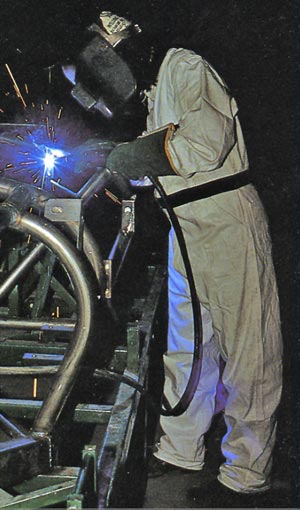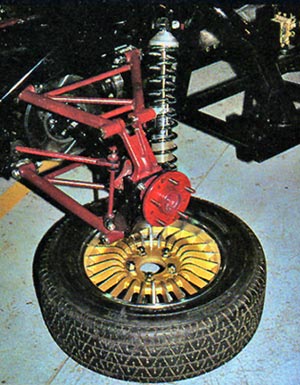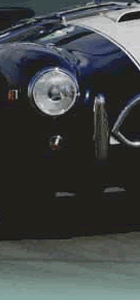Creating the Aurora
- L. Jemmett, production team member
___________________________
REFLECTIONS - 1952 to 1983
Aurora Cars Limited
As Aurora owners we surely pay due respect to Carroll Shelby.
His legacy as a champion driver, team manager, visionary and philanthropist
defines a life well lived. His legal efforts, however, to suppress
proliferation of replicas of the Cobra racing cars he created
remain to this day, blunting the vision of many replica builders
who see their work more as a tribute to him.
However obvious the Cobra look of their sports cars, Aurora Cars
Limited, like Shelby, drew styling ques from earlier roots. Aurora
never used the name Cobra and never set about to build a racing
replica. The Aurora was engineered as a pure sports car, and it
is with this notion we look here at its lineage from the style
and engineering perspectives.
John "Toj" Tojeiro 1923-2005
John Tojeiro was a gifted engineer who built racing specials as
a sideline to his small business in painting and repairing bodywork.
In 1952 in England, he was commissioned by Cliff Davis to design
a new race car with a light weight tubular chassis. It would be
fitted with a 2-liter Bristol engine positioned well aft of the
front wheels for optimal balance. The body would be styled after
the little Ferrari 166MM and 212 "Barchetta" from Touring
of Milan. (The Ferrari 166 was named for the cubic centimeters
displacement for each of its 12 cylinders, putting out 140HP).
This two seater was fabricated by Gray and Rich Panelcraft in
Hammersmith, licensed LOY 500 as a "Tojeiro-Bristol"
in 1953. Davis enjoyed a successful racing season that year in
his new car.
Tojeiro was soon commissioned by Ernie Bailey to build a similar
car, but fitted with a stronger Lea Francis engine. Eventually
Bailey and Vin Davison introduced Tojeiro to AC, whose chairman
Charles Hurlock quickly took the car into production. Bailey purchased
AC in 1953, and his newly named AC "Ace," a car very
similar to the Tojeiro-Bristol was warmly received at the London
Motor Show in 1953, with sales of 147 cars to follow.
Alan Turner redesign -
Before the 1954 London Motor Show the body was redesigned by
Alan Turner, with headlights and tail lights raised to meet export
requirements, and, like the Tojiero Bristol Special, retained
the four-wheel independent suspension. In the late 50s the AC
Ace would place among the top ten finishers at LaMans, with the
earlier but more powerful Bristol 1991cc six cylinder engine.The
body style remained unchanged through the 1950s as the Ace enjoyed
increasing popularity in club racing. In total about 735 Aces
were built up to 1963, some 47 with the heavier and weaker Ford
Zephyr engine. AC officially stopped production of the Ace in
1963, and began producing the AC Cobra for UK and Europe, while
producing Shelby Cobras for US export.
Carroll Shelby
Now 1961, with sales dwindling, AC was approached by Carroll Shelby
with the idea of building 100 cars with small block Ford V-8s
in order to qualify in production class racing. Several other
manufacturers in the UK were also approached with the idea, but
declined. Ford stepped up and offered the new 221 cubic Inch V-8,
soon punched out to 260c.i. producing 260hp. AC partly owned a
sheet metal factory which supplied the skin, and by 1962 a prototype
without the powertrain was completed and transported to the US.
By early 1963, 75 of Shelby's "Cobra" cars were sold
for street and racing. By June that year 125 had been built, the
50 latest featuring the Mk II improvements including the 289 cu
V-8, improved cooling with side vents, rack and pinion steering,
and other handling improvements. Many 1962-63 "Mk I's"
were updated to these Mark II specs, blurring the change-over
point from Mk I to Mk II.
Shelby knew racing was key to improving performance and reliability,
and 1963 the lighter Cobras placed 1 and 2 at Riverside, beating
the new Corvette Sting Rays by a large margin. Note the dramatic
difference in tire width, from high speed Le Mans racing to US
short track acceleration demands.
The standard 1964 Shelby Cobra 289, weighing in at 984 kilograms,
or 2214 lbs, accelerated from 0-60mph in 5.5 seconds with a 15.3
mpg burn rate. A total of 580 AC Cobra Mk II's were made for Europe
and the US, with 65 as pure racing cars, or prototypes. 61 were
right hand drive for the UK market. The 1964 AC Cobra Mk II has
evolved to the shape familar to Aurora owners in most every detail.
Aurora Cars Limited
Aurora manufactured replicas of the 1964 AC Cobra in exacting
detail from 1981-1983 under original ownership, delivering between
157-170 exquisite cars (some later delivered partially completed).
With 450 man hours in each car, the Aurora was uniquely manufactured
in many ways.

With dual plane tubular space frame, four wheel independent suspension
and disc brakes (inboard rear for less unsprung weight), Salisbury
(Jaguar) differential, luxurious Connolly leather interior, Smiths
guages, five layers of wet sanded acrylic laquer and even air
conditioning, the Aurora had no equal.

It was the only replica subjected to the rigors of US DOT specifications
and trials and EPA compliance. In 1981 this meant crash testing,
elaborate emissions supression, 5-mph bumpers, side marker lights,
steel reinforced doors and much more. Every Aurora was delivered
street legal in 50 states, an achievement unique to Aurora Cars
Limited among replica manufacturers.



